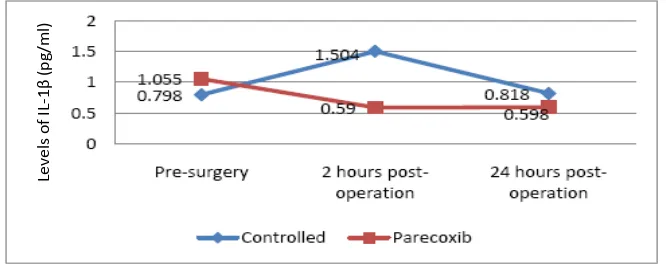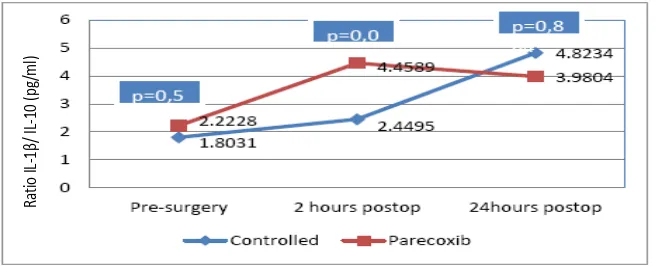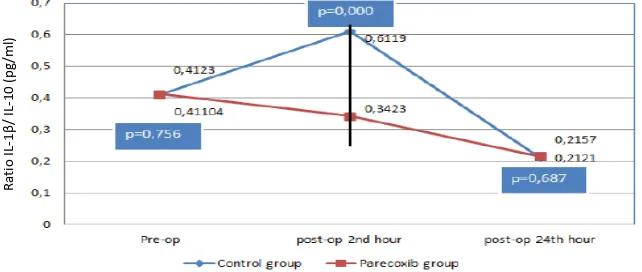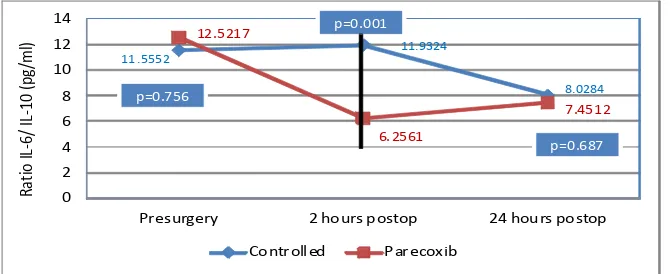Correspondence:
Muhammad Ramli Ahmad, Department of Anesthesiology, Intensive Care and Pain Management, Faculty of Medicine, Hassanudin University, Dr. Wahidin Sudirohusodo General Hospital
Jl. Perinis Kemerdekaan KM 10, Makassar, Indonesia
Mulimodal Analgesic Efect on Proinlammatory and Ani-inlammatory
Cytokines Serum
Muhammad Ramli Ahmad,1 Tatang Bisri2
1Department of Anesthesiology, Intensive Care and Pain Management, Faculty of Medicine, Hassanudin University-Dr. Wahidin Sudirohusodo General Hospital
2Departement of Anesthesiology and Intensive Care, Faculty of Medicine Universitas Padjadjaran-Dr. Hasan Sadikin General Hospital
Abstract Objecive: To invesigate the efect of combinaion epidural bupivacaine and intravenous parecoxib analgesia on immune response in paients who underwent open reducion and internal ixaion of the lower limb under epidural anesthesia.
Methods: This research was conducted using the randomized, placebo-controlled double blind trial method on 52 paients who were randomly divided into 2 groups: the Parecoxib group which received 40 mg intravenous parecoxib for 30 minutes before incision and the control group which received an equal volume of 0.9% normal saline. Both groups received epidural anesthesia and postoperaive epidural 0.125% bupivacaine analgesia coninously. Venous blood samples were obtained before parecoxib administraion, 2 and 24 hours ater the surgery. The data were analyzed using Mann Whitney U and independent t tests (p<0.05).
Results: There was a signiicant diference between the two groups (p<0.05) in IL-1β, IL-6, IL-10 levels and proinlammatory to ani-inlammatory raio, 2 hours ater surgery.
Conclusions: Mulimodal analgesic combinaion of 40 mg IV parecoxib and 0.125% bupivacaine epidural analgesia have the efect to alter and stabilize the systemic immune response.
Keywords:Cytokines, epidural analgesia, interleukins, immune response, parecoxib, issue damage
IJIHS. 2014;2(1):15–22
Introducion
Postoperaive pain brings a signiicant impact on paients. However, the management of the postoperaive pain is sill occasionally overlooked even though there are recent developments and extensive understandings on postoperaive pain mechanism. Almost half of all postoperaive paients had not received proper postoperaive pain management and about 80% of them were sill in acute pain postoperaively.1 Research conducted in Maastricht University Hospital, the Netherlands, showed that about 41% of 1,490
postoperaive paients were sill in moderate to severe pain on the 1st to 4th day post-surgery in spite of the standard pain management protocol. About 30–55% of post abdominal surgery paients were sill in moderate to severe pain on the 1st day, about 20–71% of post lower extremity surgery and 30–64% of post spinal surgery were sill in moderate to severe pain on the 1st to 4th day.2
The inlammaion responses to postoperaive trauma may induce the neuroendocrine stress responses. The inlamed peripheral issue produces cytokines, i.e. Interleukin-1β (IL-β), IL-2, IL-6 and tumor necrosis factors (TNF). The humoral signal induces the cyclooxygenase 2 (COX-2) acivity and, therefore, prostaglandin synthesis in central nervous system (CNS) which leads to sensiizaion. This cannot be inhibited efecively by regional anesthesia. However, the Received:
September 17, 2013 Revised:
centrally-acing COX-2 inhibitor administraion will reduce this acivity.3 The circulaion of the T-helper cell (Th) is associated with cytokine expression. Th1 cell is associated with immune cells, e.g. interferon γ (INF-γ), IL-2 while Th2 produces IL-4, IL-5 and IL-10, which are associated with the immunosupression response. The balance of IL-6 and IL-10 is an important factor in the series of immune responses.4 The COX-2 expression is simulated by proinlammatory cytokine and inhibited by ani-inlammatory mediators, such as IL-10 and IL-4, through transformaion growth factor-beta (TGF-beta).5
A study on preempive analgesia by using epidural technique associated with pain score and the cytokine producion proved that the use of epidural preempive could reduce the pain score and producion of IL-1β, IL-6, IL-1ra.6 On the other hand, another research showed that epidural technique could only inhibit the neural line and could not inhibit the humoral line.7 The use of rofecoxib combinaion and spinal anesthesia on pelvic surgical operaion showed reducion in IL-6 and prostaglandin E2 (PGE2) levels in cerebrospinal luid (CSS), plasma, and wound side while TNFα dan IL-1β could not be detected both in plasma and CSS.8 A study on the efect of a single parecoxib administraion on cytokine response, and stress response as well as the administraion of ophthalmological postoperaive analgesia showed signiicant decreases in IL-6, IL-8, corisol adrenocoricotropic, and VAS (p<0.001) compared to the control groups. There were no decreases in epinephrine and norepinephrine levels in both group.9
Another study suggested that the use of mulimodal analgesia with IV tramadol and IV lurbuprofen combinaion in thoracotomy
postoperaive pain management were able to reduce the pain score, IL-6, and postoperaive C-reacive protein (CRP) compared to the pain score in the control groups. The TNF-α level was similar for both groups.10 Epidural preempive analgesia showed lower pro-inlammaion/ani-inlammatory cytokine raio than the control groups, but the diference was not signiicant. This proved that epidural preempive could not reduce central sensiizaion through the hormonal line.11
The efect of centrally-acing mulimodal analgesia COX-2 inhibitor combined with epidural analgesia on immune response and pain intensity has not been studied extensively. Hence, in order to improve our understanding, holisic studies are needed to examine the inlammaion and ani-inlammatory cytokine level as well as the IL-6/IL-10 raio in paients receiving 40 mg IV parecoxib and with 0.125% epidural bupivakain analgesic combinaion.
Methods
This study was conducted in Dr. Wahidin Sudirohusodo General Hospital, Makassar from April to July 2012 and was approved by the Ethics Commitee of Hasanuddin University Makassar. All paients who met the inclusion criteria were consecuively enrolled. This study was performed using the clinical double-blind randomized case-control study design.
Male paients who underwent open reducion internal ixaion elecive surgical operaion of lower hip fracture with epidural anesthesia and who met the following inclusion criteria, i.e. PS ASA 1–2, 18–50 years of age, height more than 155 cm and normal BMI, were included in this
Table 1 Demographic Characterisics of Paients
Variable
Group
p value*) Parecoxib (n=26) Control (n=26)
Range Mean±SD Range Mean±SD
Age 23–50 35.96±10.25 18–48 29.15±9.43 0.61
Height 157–174 16.8 ±4.43 154–173 165.15± 5.51 0.53
BMI 20.20–24.38 21.93±1.38 20,01–24,80 21.18±1.36 0.36
Duraion of operaion 100–175 141.73±20.73 100–175 139.61±25.33 0.57 Consumpion of local anesthesia 90–135 110.76±22.87 90–135 110.76±22.87 0.57
study. Paients who had contraindicaions for epidural catheter placement, history of allergy to study medicines, cardiovascular disease, renal failure, liver damage, signs of SIRS, under NSAID less than 5 days before the procedure, and under coricosteroid were excluded. Paients who experienced intraoperaive complicaions, needed resurgery during observaion period, needed blood transfusion, had non-opimal epidural anesthesia, and underwent more than 3-hour operaive procedure were also excluded. Samples were obtained using consecuive random method. Fity two paients were enrolled and divided into 2 groups, which was parecoxib group and control group.
Paients were given 5 mg alprazolam prior to the operaion as the inclusion criteria met. Epidural catheter inserion at the level of of L2–3 or L3–4 was done at the operaion room.Fourty milligrams intavenous Parecoxib was given to the parecoxib group about 30 minutes prior to incision, while the control group were given 2 cc 0.9% NaCL. Bupivakain epidural anesthesia, 0.5% 1–2 mL/dermatome, was administered 30 minutes prior to the incision unil the block reached T12-S2. During the procedure, paients were sedated with 25–100 µg/kg/minute IV propofol. Ater the procedure, both groups were given coninuous 0.125% bupivacaine, 5 cc/hour, as the post-operaive analgesia. Blood samples was taken 2 and 24 hours ater the procedure and the IL-1β and IL-6 serum levels were measured. The pain intensity was assessed using Numeric Raing Score (NRS) and 3 mL of 0.125% bupivacaine was given when the NRS was more than 4/10. The Human Interleukin Immunoassay Quanikine HS serum (R & D System) was used
to measure the cytokine level using the Enzyme Linked Immunosorbent Assay with ELISA Reader Organon 680 (Biorad) equipment.
The collected data were then processed with SPSS 15.0 sotware for Windows. Data were examined using t test for characterisics of samples. The diferences of variables between both groups were examined using Mann-Whitney U-test. The number of samples needed in each group were 26 (α=0.05 and power=0.8). Diferenial test between variables in both groups was considered signiicant if p<0.05. Data are presented in mean ±SD and minimum-maximum/median.
Results
Demographic characterisics of both groups in age,height, body mass index, duraion of operaion, consumpion of local anesthesia and ASA between the two group, therefore the two group were considered homogenous (Table 1).
The diference of IL-1β level between the parecoxib group and the control group was not staisically signiicant (p>0.05), both in pre-operaion and 24 hours post-pre-operaion levels. At two hours ater the surgery, the IL-1β level in parecoxib group was signiicantly diferent (p<0.05) from the control group (Fig. 1).
The IL-6 average value in parecoxib group and control group was not signiicantly diferent in pre-operaion (p>0.05) and 24 hours post-operaion (p>0.05). However, based on the ob at 2 hours of post-operaion, the parecoxib group showed a signiicantly lower level (p<0.05) than the control group (Fig. 2).
Fig. 1 Serum Interleukin -1β Level
Le
ve
ls
of
IL
-1β
(p
g/
m
Interleukin 10 level in both groups increased at two hours post-operaion and no signiicant diference was found between the level in the parecoxib group (4.46±3.51) and the control group (2.44 ±1.18) (p=0.028) (Fig. 3).
Discussion
Interleukin -1β level
Interleukin-1β, which is a protein precursor, is produced by the macrophages and monocytes, known as non-immune cells, that is acivated by ibroblast and endothelial cell during the occurence of issue damage, infecion, invasion and inlammaion. It is now found that IL-1β also appears on nocicepive neurons in the dorsal root ganglion. Interleukin-1β contributes to the systemic inlammaion through COX-2 acivaion
to form PGE2. The result of this study shows that the IL-1β level in the parecoxib group decreased at 2 hours post-operaion (p<0.05), which is signiicantly diferent from the control group. However, 24 hours ater operaion, the IL-1β level in both groups decreased.
Another study combining spinal anesthesia and rofecoxib shows that the IL-1β level was undetected in plasma and LCS at 1, 3, 9, and 24 hours ater surgery, and was only found in luid from the drain of the surgery side.8
A study on ophthalmological surgery shows that there was no signiicant diference (p>0.05) in IL-1β level between groups with parecoxib and without parecoxib.9 In that paricular study, the IL-1β level showed a tendency to incline in both groups, with the parecoxib group showing less increase.
Fig. 3 Serum IL-10 Level
Ra
tio
IL
-1β
/ I
L
-10
(p
g/
m
l)
Fig. 2 Serum Interleukin-6 Level
I
L
-6
le
ve
l (
p
g/
m
Interleukin-6 Level
Surgical procedures are associated with issue damages that acivate both local and systemic nocicepive and inlammatory responses. This is then followed by proinlammatory cytokine increases, including the IL-6.8 The Interleukin-6 as the proinlammatory cytokine plays major roles in the acute protein phase of the issue damages resuling from surgical trauma. From all body responses to surgical trauma, the IL-6 level is reported to be the sensiive indicator of surgical stress. The Interleukin-6 concentraion in a normal condiion is usually low and may not be detected.10 Ater a trauma, the plasma IL-6 concentraion can be detected in 60 minutes and will reach its peak ater 4–6 hours. It starts to decrease between 24–48 hours ater the trauma; however, it can persist unil 10 days. Interleukin-6 is the most sensiive marker of issue damages. The longer the IL-6 persists in the plasma, the higher the post-operaive morbidity will be.13
The results of control group in this study are in agreement with the theories about IL-6. It is found that the IL-6 level increased at the 2nd and 24th hour ater surgery (p<0.05).
This inding is in line with the indings in a study performed on paients who underwent a transabdominal hysterectomy procedure using epidural analgesia preempive technique, which was followed by Paient Controlled Epidural Analgesia (PCEA), where the IL-6 level increased in the irst 24 hours post-operaion (p<0.03) but it was lower than PCEAgroup (p<0.04).6
The IL-6 dynamic in the control group is in line with the IL-6 serum level dynamic in a study on paients who underwent lower extremity surgical operaion with epidural preempive technique.11 Interleukin-6 will directly and indirectly afect the
producion of COX-2 and prostaglandin through IL-1. It is presumed that IL-6 can also acivate the glia cell.13
It is stated that two pathways may be induced by peripheral inlammaion. First, it induces the producion and spread of COX-2 and Prostaglandin E synthase (PGES) at the inlammaion site, leading to the sensiizaion of nerves innervaing the injured issue by reducing their threshold and increasing their excitability. Second, the humoral pathway will be induced by the peripheral inlammaion and this will increase the producion and spread of COX-2 in CNSthrough NF-kβ by IL-1β, TNF-α, and IL-6.7
The results of this study show that the IL-6 level in the parecoxib group decreased 2 hours ater the surgery when it is compared to the pre-surgical value (p<0.05) and it increased again at 24 hours ater surgery (p<0.05). In the control group, the IL-6 level keeps increasing during 24 hours ater the surgery. There is a staisically signiicant diference of IL-6 level in both groups, paricularly at two hours ater the surgery (p<0.05). No signiicant diference in IL-6 level between both groups before the surgery and 24 hours ater surgery (p>0.05). These indings are presumably resulted from the inhibiion of prostaglandin synthesis by parecoxib, which in turn afects the IL-6 producion.
The Interleukin-6 producion is iniiated by the PGE2 receptor agonists. E-series prostaglandin receptors (EP) are the simulated EP1 which enhances mobilizaion of calcium (Ca) from extracellular to intracellular compartment, while EP2 and EP4 receptors as G-protein-coupled receptors acivate the cAMP and NF-kβ level.14
Recently, it is discovered that inlammaion responses caused by surgical trauma cannot be
Fig. 4 Raio IL1β/IL-10
Ra
tio
IL
-1β
/
IL
-10
(p
g/
m
efecively inhibited merely by peripheral nerve inhibiion or single neuraxial block. Peripheral inlammaion induces COX-2 spread and PGES expression in CNS. Studies on animal subjects found that the proinlammatory cytokine, IL-6, induces COX-2, both in the inlamed peripheral issue and CNS. In postoperaive pain, IL-6 is known as a major mediator that increases the COX-2 in the CNS. New evidence has shown that parecoxib administraion works centrally by inhibiing the COX-2; therefore, decreasing the expression of PGE2. This is diferent from ketorolac since this agent inhibits the COX-2 peripherally.15
The results of this study support the indings in a study on preempive analgesia that used 40 mg parecoxib adminitered intramuscularly before an ophthalmological surgery was performed under general anesthesia.9 It has been proven that the IL-6 plasma level in early post-operaion unil 6 hours post-surgery decreases (p<0.05) compared to the control group but the diference of IL-6 level at 24 hours ater surgery is not signiicant compared to the control group.9
Based on a previous study that used oral preempive COX-2 inhibitor combined with spinal anesthesia in arthroplasty, it is found that the IL-6 plasma experienced dynamic increases at the irst 1, 3, 9, and 24 hours, and then decreases at 30 hours post-operaion (p<0.05). Overall, the IL-6 level is lower than in the control group. This study is also supported with the measurement of PGE2 plasma level, which decreases at all imes of the postoperaive assessment (p<0.05).8
The results of this study contradicts indings from a previous study that involved the use of IV COX-2 inhibitor in thoracotomy paients. In
that study, the IL-6 level in both study groups increased unil 24 hours ater the surgery and decreased ater that point. However, the IL-6 level in the treatment group was lower than in the control group (p<0.05).10
Diferences of IL-6 dynamic in those studies may be caused by the use of diferent types of COX-2 inhibitors. The similarity found among these studies is that in the group receiving COX-2 inhibitor, the IL-6 level is found to be lower than in the control group, although the IL-6 increases at the irst 24 hours ater surgery. These indings show that the administraion of COX-2 inhibitor has an efect on the IL-6 dynamic and level.
Therefore, a suggesion is proposed that the administraion of 40 mg IV parecoxib 30 minutes before a surgical incision can reduce and stabilize the IL-6 level. From this, we can conclude that parecoxib afects the dynamic of IL-6.
Interleukin-10 Level
The involvement of IL-10 in pain is thought to be through the efect on PGE2. The Interleukin 10 can inhibit the producion of prostaglandin (PG) from peripheral blood mononuclear cells which is simulated by the proinlammaion cytokine. Ani-inlammatory cytokine increases ater a trauma to maintain the balance between the ani-inlammaion cytokine and the proinlammatory cytokines. The Interleukin 10 also inhibits the producion of PG through a feedback mechanism.17 Results of this study show that the level of IL-10 increases in both groups and the diference is not signiicant. This shows that epidural analgesia, with or without parecoxib, causes an ani-inlammatory acion through IL-10 response. This study is in line with
Fig. 5 Raio IL-6 to IL-10
Presurgery 2 hours postop 24 hours postop
another study that found IL-10 level increase ater parecoxib administraion.17
Proinlammatory to ani-inlammatory cytokines raio
The balance between proinlammatory and ani-inlammatory cytokines are very important to maintain the homeostasis. In this study, the parecoxib group has lower 6/10 and the IL-1β/IL-10 raios at the 2nd hour post-operaion compared to control group.This shows that the administraion of parecoxib has an efect on the systemic immune response. Peak levels of ani-inlammatory cytokine IL-10 occurs two hours ater the surgery and is higher in the parecoxib group. An increase in the raio of IL-6 to IL-10 indicates a correlaion with a poor outcome. This study has in line with the previous study.18 A diferent result is shown in an animal study in which the IL-6 and IL-10 levels decreases ater parecoxib administraion with poor outcome.
Mulimodal Analgesia
The mulimodal analgesia concept has been introduced more than a decade ago as a technique to increase the efect of analgesia and decrease unexpected incidences related to
the use of opioid.The raionale for this strategy is the achievement of suicient analgesia due to the addiive or synergisic efects between diferent classes of analgesics.3This method can decrease the dosage of each individual drug, thus decreasing the adverse efects from each drug used in surgical procedure. Nowadays, the American Society of Anesthesiologist Task Force on Acute Pain Management suggested the use of this mulimodal analgesia.3,18,19
The use of mulimodal analgesia technique aims to decrease the stress response caused by surgical operaions, reduce the mobility pain, ease the body recovery ater surgery and increase the clinical improvement as well as decreasing the side efects of medicaions.20 In conclusion, the combinaion of 40 mg of IV parecoxib and 0.125% bupivacaine epidural analgesia can change and stabilize the systemic immune response. This combinaion technique can also be used as a prevenive mulimodal analgesia to prevent chronic pains. Further studies are needed to measure the change in prostaglandin level as a direct efect from COX-2 inhibitor and also to observe paients’ clinical outcome.
References
1. Apfelbaum JL, Chen C, Mehta SS, Gan TJ. Postoperaif pain experience: result from a naional survey suggest postoperaif coninues to be undermanage. Anesth Analg. for controlling acute postoperaive pain. Curr Opin Anaesthesiol. 2009;22:588−93.
4. Mahdy AM, Galley HF, Abdel-Wahed MA, El-Korny KF, Sheta SA, Webster NR. Diferenial modulaion of interleukin-6 and interleukin-10 by diclofenac in paient undergoing major surgery. Br J Anesth. 2002;88(6):797−802.
5. Almaida JLJd, Jukemura J, Coelho AMM, Patzina RA, Machado MCC, Cunha JEMd. Inhibiion of cyclooxygenase-2 in experimental severe acute pancreaiis. Clinics. 2006;6(4):301−6.
6. Beilin B, Bessler H, Mayburd E, Smirnov G, Dekel
on pain and cytokine producion in postoperaive period. Am Societ Anesth. 2003;98(1):151−5. 7. Kawasaki T, Ogata M, Kawasaki CK, Okamoto,
Sata T. Efects of epidural anaesthesia on surgical stress-induced immunosuppression during upper abdominal surgery. Br J Anaesth. 2007;98(2):196– 203.
8. Buvanandran A, Kroin J, Berger R, Hallab N, Saha C, Negrescu C, et al. Upregulated of prostaglandin E2 and interleukins in the central nervous system and peripheral issue during and ater surgery in humans. Anesthesiology. 2006;104(3):403−10. 9. Xu LL, Shen JJ, Zhou HY. Efects of parecoxib
sodium preemive analgesia on perioperaive cytokine responses and stress responses in paients undergoing opthalmology surgery. Chin J Med Gen. 2010;90(27):1893−6.
10. Esme H, Kesli R, Apliogullari B, Duran FM, Yoldas B. Efect of lurbiprofen on CRP, TNF-α, IL-6, and postoperaive pain of thoracotomy. Int J Med Sci. 2011;8(3):816−221.
11. Ahmad MR. Peran analgesia epidural preemif
aniinlamasi pada pasca bedah ekstremitas
bawah [desertaion]. Makassar: Universitas
Hasanuddin; 2012.
12. Beillin Y, Hossain S, Bodian CA. Numeric raing scale and labor epidural analgesia. Anesth Analg. 2003;109(3):943−50.
13. Jun-hua Z, Yu-guang H. Immune system: a new look at pain. Chin Med J. 2006;119(11):930−8. 14. Hamza M, Dionne RA. Mechanisms of non-opioid
analgesics beyond cyclooxygenase enzyme inhibiion. Curr Mol Pharm. 2009;2(1):1−14. 15. Katz J, Clarke H. Prevenive analgesia and
beyond: current status. evidence, and future direcions. In: Rice AS, Jusins D, Newton T, Howard RF, Miaskowski CA, editors. Clinical pain management. 2nd ed. London: Hodder Arnold; 2008. p. 154−91.
16. Kim MH, Hahm TS. Plasma levels of Interleukin-6 and Interleukin-10 are afected by ketorolac as an adjunct to paient-controlled morphine ater abdominal hysterectomy. Clin J Pain.
2001;17(1):72−7.
17. Wu Q, Purusram G, Wang H, Yuan R, Xie W, Gui P, et al. Efecacy of parecoxib on systemic
inlammatory response assosiated with cardiopulmonary bypass during cardiac surgery. Br J Clin Pharmacol. 2013;75(3):769−78.
18. White PF, Sacan O, Tufanogullari B, Eng M, Nuangchamnong N, Ogunnaike B. Efect of short term postoperaive celecoxib administraion on paient outcome ater outpaient laparascopic surgery. Can J Anaesth. 2007;54(5):342−8. 19. Fitzerald GA, Patrono C. Coxib, selecive
inhibitors of ciclooxygenase-2. N Eng J Med. 2001;345(6):433−42.




